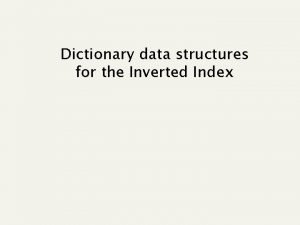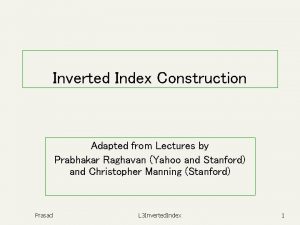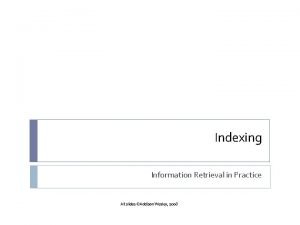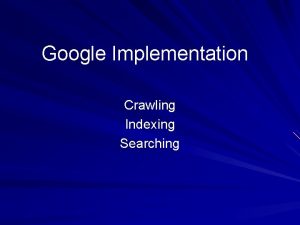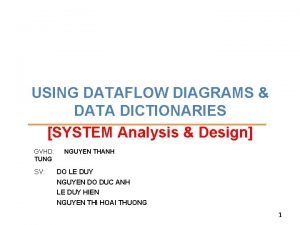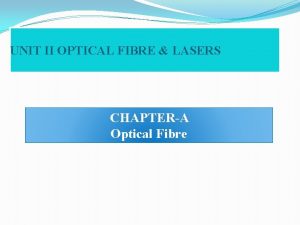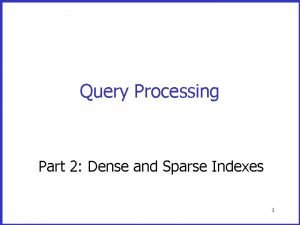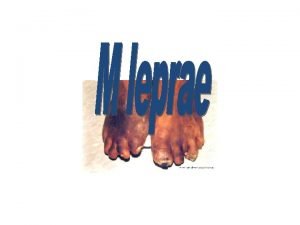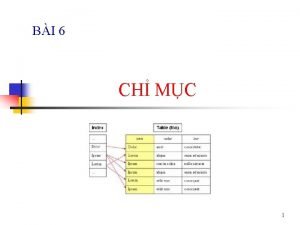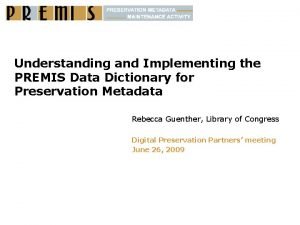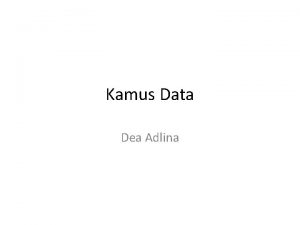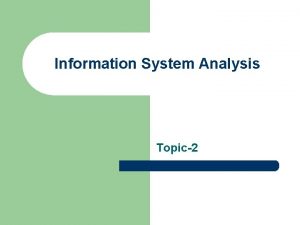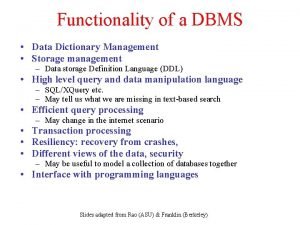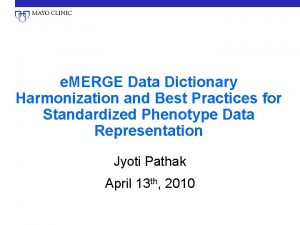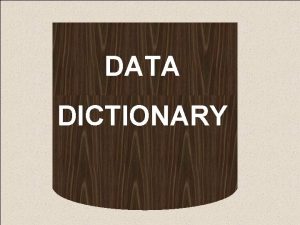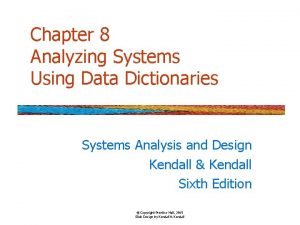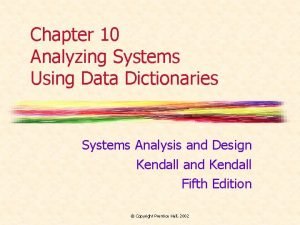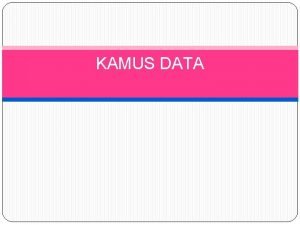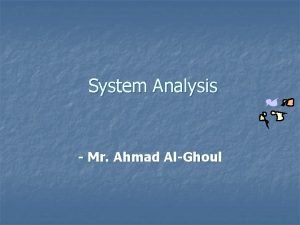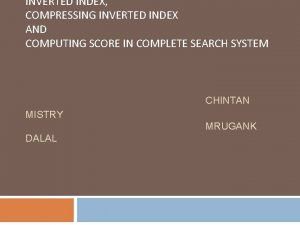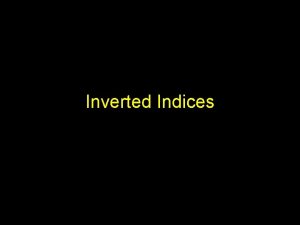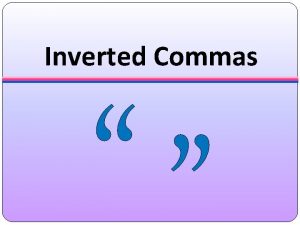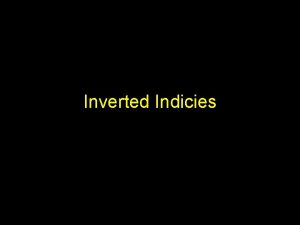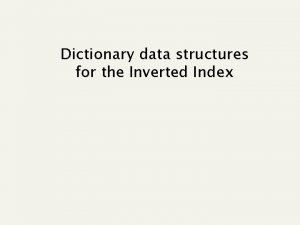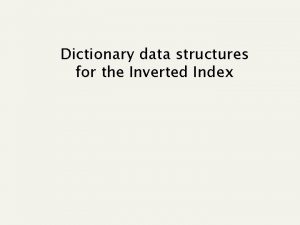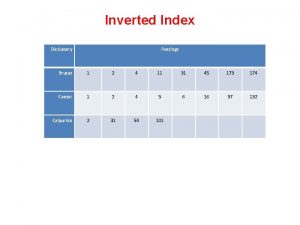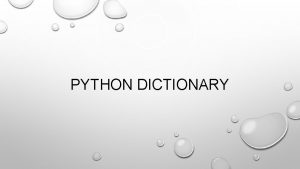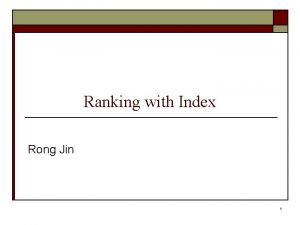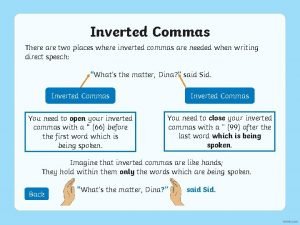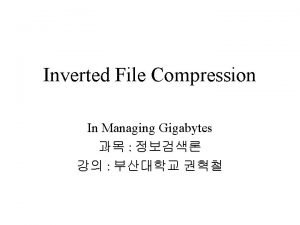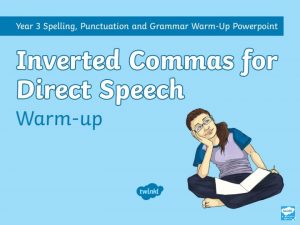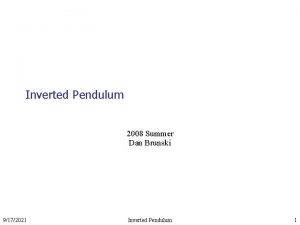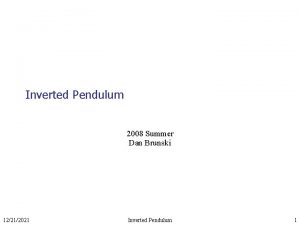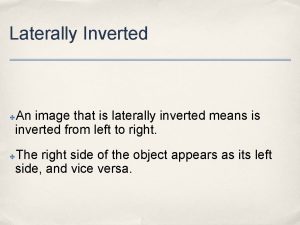Dictionary data structures for the Inverted Index Ch



![Sec. 3. 1 A naïve dictionary n An array of struct: char[20] 20 bytes Sec. 3. 1 A naïve dictionary n An array of struct: char[20] 20 bytes](https://slidetodoc.com/presentation_image/2525070015d8c0fe0ca99b3cd89cb8ff/image-4.jpg)






























- Slides: 34

Dictionary data structures for the Inverted Index

Ch. 3 This lecture n Dictionary data structures n n n Exact search Prefix search “Tolerant” retrieval n n Edit-distance queries Wild-card queries Spelling correction Soundex

Sec. 3. 1 Basics n The dictionary data structure stores the term vocabulary, but… in what data structure?
![Sec 3 1 A naïve dictionary n An array of struct char20 20 bytes Sec. 3. 1 A naïve dictionary n An array of struct: char[20] 20 bytes](https://slidetodoc.com/presentation_image/2525070015d8c0fe0ca99b3cd89cb8ff/image-4.jpg)
Sec. 3. 1 A naïve dictionary n An array of struct: char[20] 20 bytes int 4/8 bytes Postings * 4/8 bytes n How do we store a dictionary in memory efficiently? n How do we quickly look up elements at query time?

Sec. 3. 1 Dictionary data structures n Two main choices: n n Hash table Tree Trie Some IR systems use hashes, some trees/tries

Hashing with chaining

Key issue: a good hash function Basic assumption: Uniform hashing Avg #keys per slot = n * (1/m) = n/m = a (load factor) m=

In practice A trivial hash function is: prime Integer (if string? ) The current version is Murmur. Hash (vers 3) yields a 32 -bit or 128 -bit hash value.

Another “provably good” hash L = bit len of string m = table size ≈log 2 m Key k 0 k 1 k 2 kr r ≈ L / log 2 m a n a 0 a 1 a 2 ar Each ai is selected at random in [0, m) prime not necessarily: (. . . mod p) mod m

Sec. 3. 1 Hashes n Each vocabulary term is hashed to an integer n Pros: n n n Lookup is faster than for a tree: O(1) on avg Turn to worst-case by Cuckoo hashing Cons: n Only exact search: e. g. judgment/judgement n If vocabulary keeps growing, you need to occasionally do the expensive rehashing n Cuckoo hash «limits» those rehashes

Cuckoo Hashing A 2 hash tables, and 2 random choices where an item can be stored

A running example A B C F E D

A running example A B E D C F

A running example A B G E D C F

A running example E G B A C F D We reverse the traversed edges keeps track of other position Random (bipartite) graph: node=cell, edge=key

1 cycle, not a problem A B D G F G D F B A If #cells > 2 * #keys, then low prob of cycling (but <50% space occupancy)

The double cycle (!!!) E B C G A D D A E B G D G C A F C E B D A F F B F E C G If #cells > 2 * #keys, then low prob of 1 cycle Low prob of 2 joined-cycles

Extensions for speed/space n More than 2 hashes (choices) per key. n Very different: hypergraphs instead of graphs. n Higher memory utilization n 3 choices : 90% 4 choices : about 97% 2 hashes + bins of B-size. but more insert time (and random access) n Balanced allocation and tightly O(1)-size bins n Insertion sees a tree of possible evict+ins paths more memory. . . but more local

Prefix search

Prefix-string Search Given a dictionary D of K strings, of total length N, store them in a way that we can efficiently support prefix searches for a pattern P over them. Ex. Pattern P is pa Dict = {abaco, box, paolo, patrizio, pippo, zoo}

Trie: speeding-up searches 0 s 1 y z 2 stile aibelyite zyg 5 1 etic ial 2 3 5 2 omo 7 czecin ygy 4 6 Pro: O(p) search time = path scan Cons: edge + node labels + tree structure

Sec. 3. 1 Tries Do exist many variants and their implementations n n Pros: n Solves the prefix problem Cons: n Slower: O(p) time, many cache misses n From 10 to 60 (or, even more) bytes per node

2 -level indexing 2 advantages: • Search ≈ typically 1 I/O + in-mem comp. • Space ≈ trie built over a subset of strings Internal Memory CT on a sample A disadvantage: • Trade-off ≈ speed vs space (because of bucket size) systile szaibelyite Disk systile syzygetic syzigial syzygygy szaibelyite szczecin szomo

Front-coding: squeezing dict systile syzygetic syzygial syzygy 2 http: //checkmate. com/All_Natural/Applied. html http: //checkmate. com/All_Natural/Aroma 1. html http: //checkmate. com/All_Natural/Aromatic_Art. html http: //checkmate. com/All_Natural/Ayate. html http: //checkmate. com/All_Natural/Ayer_Soap. html http: //checkmate. com/All_Natural/Ayurvedic_Soap. html http: //checkmate. com/All_Natural/Bath_Salt_Bulk. html http: //checkmate. com/All_Natural/Bath_Salts. html http: //checkmate. com/All/Essence_Oils. html http: //checkmate. com/All/Mineral_Bath_Crystals. html http: //checkmate. com/All/Mineral_Bath_Salt. html http: //checkmate. com/All/Mineral_Cream. html 5 33 45% 5 0 33 34 38 38 34 35 35 33 42 25 25 38 33 http: //checkmate. com/All_Natural/ Applied. html roma. html 1. html tic_Art. html yate. html er_Soap. html urvedic_Soap. html Bath_Salt_Bulk. html s. html Essence_Oils. html Mineral_Bath_Crystals. html Salt. html Cream. html 0 http: //checkmate. com/All/Natural/Washcloth. html. . . http: //checkmate. com/All/Natural/Washcloth. html . . . Gzip may be much better. . .

2 -level indexing 2 advantages: • Search ≈ typically 1 I/O + in-mem comp. • Space ≈ Trie built over a subset of strings Internal Memory CT on a sample and front-coding over buckets A disadvantage: • Trade-off ≈ speed vs space (because of bucket size) systile szaielyite Disk …. 70 systile 92 zygeti c 85 ial 65 y 110 szaibelyite 82 czecin 92 omo….

Spelling correction

Sec. 3. 3 Spell correction n Two principal uses n n n Correcting document(s) being indexed Correcting queries to retrieve “right” answers Two main flavors: n Isolated word n n n Check each word on its own for misspelling But what about: from form Context-sensitive is more effective n n Look at surrounding words e. g. , I flew form Heathrow to Narita.

Sec. 3. 3. 2 Isolated word correction n n Fundamental premise – there is a lexicon from which the correct spellings come Two basic choices for this n A standard lexicon such as n n n Webster’s English Dictionary An “industry-specific” lexicon – hand-maintained The lexicon of the indexed corpus n n n E. g. , all words on the web All names, acronyms etc. (including the mis-spellings) Mining algorithms to derive the possible corrections

Sec. 3. 3. 2 Isolated word correction n Given a lexicon and a character sequence Q, return the words in the lexicon closest to Q n What’s “closest”? n We’ll study several measures n n n Edit distance (Levenshtein distance) Weighted edit distance n-gram overlap

Sec. 3. 3. 4 Brute-force check of ED Given query Q, n enumerate all character sequences within a preset (weighted) edit distance (e. g. , 2) n n Intersect this set with list of “correct” words Show terms you found to user as suggestions How the time complexity grows with #errors allowed and string Length ?

Sec. 3. 3. 3 Edit distance n n Given two strings S 1 and S 2, the minimum number of operations to convert one to the other Operations are typically character-level n n n Insert, Delete, Replace (possibly, Transposition) E. g. , the edit distance from dof to dog is 1 n From cat to act is 2 (Just 1 with transpose) n from cat to dog is 3. Generally found by dynamic programming.

Dyn. Prog for Edit Distance n n Let E(i, j) = edit distance to transform P 1, i in T 1, j Consider the sequence of ops: ins, del, subst, match n n n Order the sequence of ops by position involved in T If P[i]=T[j] then last op is a match, and thus it is not counted Otherwise the last op is: subst(P[i], T[j]) or ins(T[j]) or del(P[i]) E(i, 0)=i, E(0, j)=j E(i, j) = E(i– 1, j– 1) if P[i]=T[j] E(i, j) = min{E(i, j– 1), E(i– 1, j– 1)}+1 if P[i] T[j]

Example +1 +1 T +1 0 0 1 P 2 3 4 p a t t 0 1 2 3 4 5 6 p t t a p a 1 0 1 2 3 2 1 1 1 2 3 2 2 1 1 4 3 2 2 2 5 4 3 3 3 6 5 4 4 4

Sec. 3. 3. 3 Weighted edit distance n n n As above, but the weight of an operation depends on the character(s) involved n Meant to capture keyboard errors, e. g. m more likely to be mis-typed as n than as q n Therefore, replacing m by n is a smaller cost than by q Requires weighted matrix as input Modify DP to handle weights
 Python inverted index
Python inverted index Inverted index construction
Inverted index construction Inverted index
Inverted index Mapreduce inverted index
Mapreduce inverted index Google inverted index
Google inverted index Miller indices visualizer
Miller indices visualizer Inverted index
Inverted index Google inverted index
Google inverted index Google inverted index
Google inverted index Inverted index
Inverted index System analysis
System analysis Biology homology
Biology homology Optical fibre
Optical fibre Dense secondary index
Dense secondary index Lepromin test ppt
Lepromin test ppt Pqli advantages and disadvantages
Pqli advantages and disadvantages Fibers
Fibers Simpson's diversity index worksheet answers
Simpson's diversity index worksheet answers Plastic limit formula
Plastic limit formula Clustered index và non clustered index
Clustered index và non clustered index Premis data dictionary
Premis data dictionary Logical view of a database
Logical view of a database Kamus data dfd
Kamus data dfd Fact finding techniques in system analysis and design
Fact finding techniques in system analysis and design Data dictionary storage
Data dictionary storage Data dictionary best practices
Data dictionary best practices Dictionary entry template
Dictionary entry template Data dictionary purpose
Data dictionary purpose Data dictionary in dfd
Data dictionary in dfd Data dictionary software engineering
Data dictionary software engineering Cucm axl schema
Cucm axl schema Data dictionary system analysis and design
Data dictionary system analysis and design Lucity data dictionary
Lucity data dictionary Definisi kamus data
Definisi kamus data Data dictionary example in system analysis and design
Data dictionary example in system analysis and design
